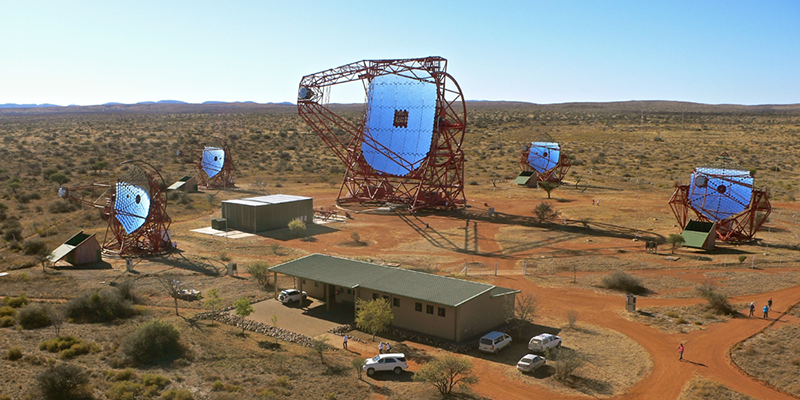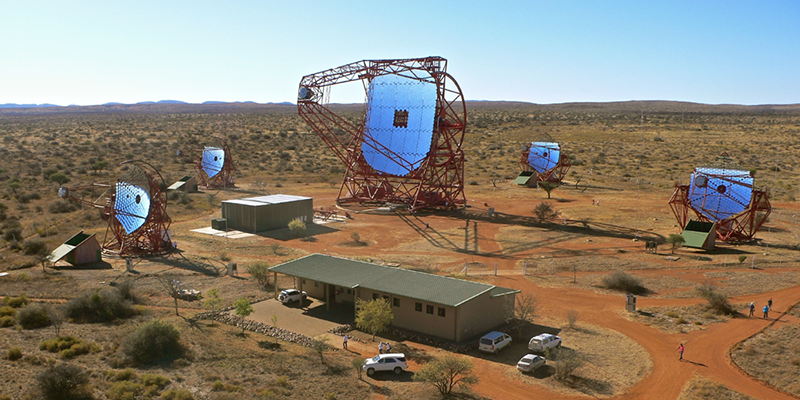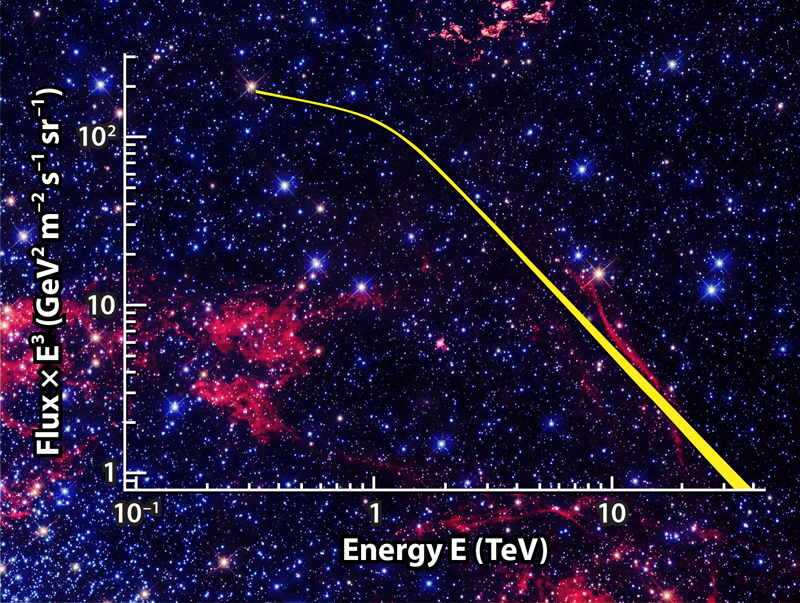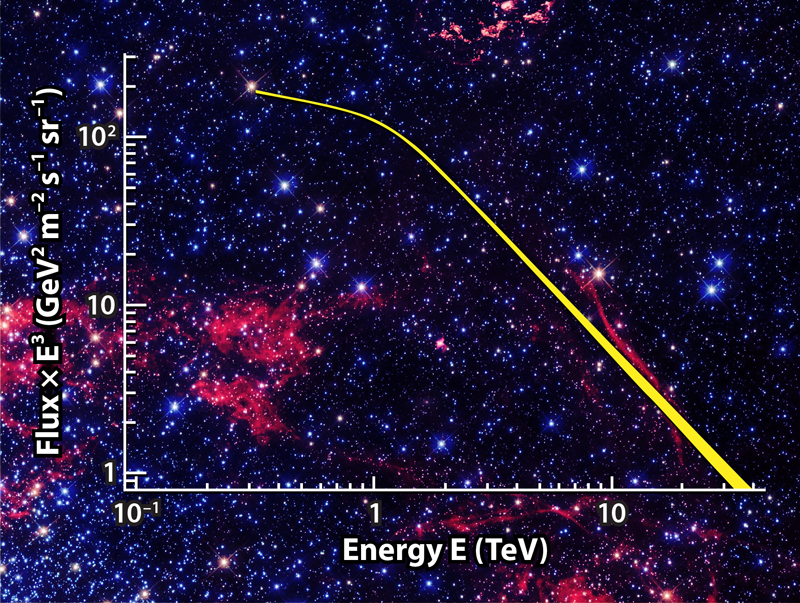Measuring the Spectrum of High-Energy Cosmic-Ray Electrons
Cosmic-ray electrons and positrons, though far fewer in number than cosmic-ray protons and other nuclei, provide essential insights into the high-energy processes taking place in our Galaxy. The High Energy Stereoscopic System (H.E.S.S.) Collaboration has made a significant breakthrough in this field with its highly detailed measurement of the cosmic-ray electron and positron spectrum, extending up to an impressive 40 TeV [1]. Previous measurements of this spectrum ended below 5 TeV [2, 3]. The H.E.S.S. team’s data, collected over 12 years, reveal unprecedented detail, especially around a distinct “break” at approximately 1 TeV where the spectral slope steepens. The results confirm that this break is among the most prominent and enigmatic features across the entire cosmic-ray spectrum, posing a challenge to our understanding of Galactic cosmic-ray origins. Additionally, the almost featureless power law detected beyond the break, sustained over a full order of magnitude in energy, places significant constraints on the role of local sources that contribute to the measured flux, as well as on alternative production mechanisms, such as the possible annihilation or decay of dark matter particles in the Milky Way. With these groundbreaking measurements, we now gain clearer insights into local cosmic-ray accelerators and on how high-energy particles propagate through the Galaxy.
Cosmic-ray electrons are high-energy particles that lose energy rapidly while traveling through the Galaxy, primarily because of interactions with Galactic magnetic fields and background radiation. This energy loss limits their range of propagation—especially at high energies—raising hopes of detecting signatures in the particle spectrum from nearby cosmic-ray accelerators. By identifying these local accelerators—most likely pulsars and supernova remnants—we may uncover the sources of cosmic rays. Another motivation for exploring the high-energy end of the spectrum lies in the potential to detect cosmic-ray electrons produced through exotic processes, such as dark matter annihilation, which may be more observable at higher energies where conventional astrophysical fluxes diminish.
A primary challenge in measuring cosmic-ray electrons, especially via indirect methods such as that used by the H.E.S.S. Collaboration, is distinguishing them from the vastly more abundant cosmic-ray protons and other nuclei. The H.E.S.S. Collaboration’s work is remarkable for the substantial volume of high-quality data it amassed. Using an array of Cherenkov telescopes in Namibia (Fig. 1), the team refined particle discrimination techniques to achieve a proton rejection ratio of 10,000 to 1, allowing electron events to be isolated with high confidence (the spectrum also includes the contribution from cosmic-ray positrons). The resulting cosmic-ray electron spectrum is best described by a broken power law: Below 1 TeV the spectral index (the exponent of the power law) is about 3.25, while above 1 TeV it steepens significantly to approximately 4.49 (Fig. 2). A greater spectral index means that the cosmic-ray flux falls off more rapidly at higher energies.
The spectral break at 1 TeV had previously been pinpointed by space-based experiments like CALET and DAMPE [2, 3]; however, these experiments lacked the capability to extend measurements into the multi-TeV range, which is essential for understanding the break’s origin. Initially, this steepening of the spectrum was thought to result from energy losses as electrons traveled through the Galaxy. Yet recent measurements of cosmic-ray nuclei, such as the boron-to-carbon ratio observed by AMS-02 (another space-based experiment), CALET, and DAMPE [4–6], suggest that the residence time of cosmic rays at this energy is incompatible with the break being primarily caused by simple energy loss. Furthermore, H.E.S.S. has shown that the break at 1 TeV is sharper than previously expected, which is inconsistent with an origin rooted in the diffusive propagation of these particles through the Galaxy.
One alternative explanation posits that the break may arise from the influence of a limited number of nearby sources. However, with measurements showing a featureless power law extending up to 40 TeV, H.E.S.S. places tight constraints on the role of such local sources, whose contribution to the observed flux would be expected to include bumps and valleys. Given the lack of a convincing explanation, these findings are likely to drive a reevaluation of cosmic-ray acceleration models, especially for electrons, in the quest to understand how Galactic accelerators energize these particles from the cold interstellar medium to relativistic speeds. The featurelessness of this power law beyond 1 TeV is also notable specifically for its lack of a distinct peak around 1.4 TeV. Previously, hints of such a peak had been spotted in data from DAMPE, which some had speculated might indicate a dark matter signature [7].
The implications of these findings are substantial. For one, they narrow down the potential candidates for nearby cosmic-ray electron sources. While dark matter annihilation becomes less likely as an explanation, more conventional sources, such as pulsars or supernova remnants, remain plausible. This work also raises intriguing questions about the mechanisms governing particle propagation at such high energies. Future research will likely concentrate on further enhancing particle discrimination, potentially through machine-learning techniques, and on extending the energy range of direct measurements to capture even-higher-energy electrons. The H.E.S.S. Collaboration has set a new standard in cosmic-ray physics, yet much remains to be uncovered about the high-energy Universe.
References
- F. Aharonian et al. (H.E.S.S. Collaboration), “High-statistics measurement of the cosmic-ray electron spectrum with H.E.S.S.,” Phys. Rev. Lett. 133, 221001 (2024).
- O. Adriani et al. (CALET Collaboration), “Extended measurement of the cosmic-ray electron and positron spectrum from 11 GeV to 4.8 TeV with the Calorimetric Electron Telescope on the International Space Station,” Phys. Rev. Lett. 120, 261102 (2018).
- DAMPE Collaboration, “Direct detection of a break in the teraelectronvolt cosmic-ray spectrum of electrons and positrons,” Nature 552, 63 (2017).
- M. Aguilar et al. (AMS Collaboration), “Precision measurement of the boron to carbon flux ratio in cosmic rays from 1.9 GV to 2.6 TV with the Alpha Magnetic Spectrometer on the International Space Station,” Phys. Rev. Lett. 117, 231102 (2016).
- O. Adriani et al. (CALET Collaboration), “Cosmic-ray boron flux measured from 8.4 GeV/n to 3.8 TeV/n with the Calorimetric Electron Telescope on the International Space Station,” Phys. Rev. Lett. 129, 251103 (2022).
- DAMPE Collaboration, “Detection of spectral hardenings in cosmic-ray boron-to-carbon and boron-to-oxygen flux ratios with DAMPE,” Sci. Bull. 67, 2162 (2022).
- Y.-Z. Fan et al., “A model explaining neutrino masses and the DAMPE cosmic ray electron excess,” Phys. Lett. B 781, 83 (2018).







